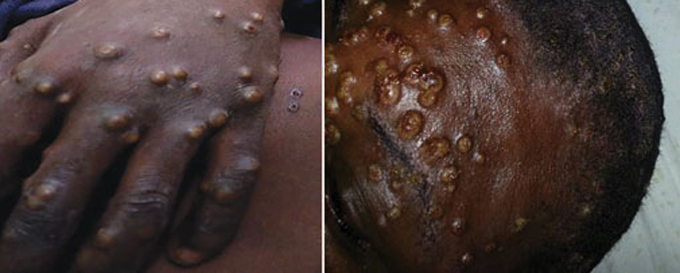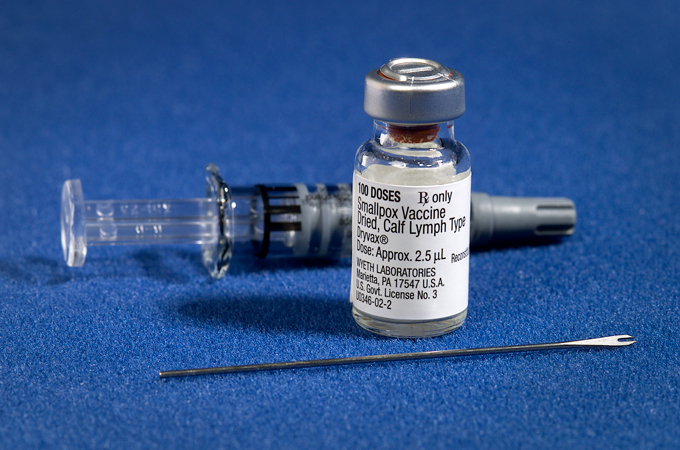An outbreak of monkeypox has some people worried that the world is on the brink of another pandemic. That’s not likely, experts say.
The concern has been fueled by more than 300 confirmed or suspected cases of the disease cropping up in 21 countries outside Africa, where the disease is endemic, since May 7. It’s the most widespread outbreak of the disease, which causes flulike symptoms, such as fever, headaches and body aches, as well as profound weakness, back pain, swollen lymph nodes and rashes that erupt into pus-filled blisters. And more cases are being added daily to a database maintained by Global.health, a group that tracks infectious diseases.
Spain, Portugal, Canada and England have recorded most of the cases. In the United States, one person each in Massachusetts, California and New York City and two in Utah have been confirmed to have monkeypox, and four others are confirmed to have Orthopoxvirus infections, the genus that includes monkeypox and smallpox. Those cases — one in New York City and Washington state and two in Florida — are presumed to be monkeypox and are undergoing confirmation at the U.S. Centers for Disease Control and Prevention.
Monkeypox spreads through close contact. “Anyone — anyone — can develop and spread monkeypox infection,” John Brooks, a medical epidemiologist at the CDC said May 23 during a news briefing. But “many of those affected in the current global outbreak identify as gay or bisexual men.”
Some of those cases have been linked to a Pride celebration and a sauna in Spain, and a fetish festival in Belgium. CDC officials hope to raise awareness of the sometimes-deadly disease ahead of June, Pride month in the United States and many other countries, Brooks said.
Right now, men who have sex with men may be at greater risk of contracting the virus, but “infectious diseases don’t care about borders or social networks,” Brooks said. Most people are at low risk of catching monkeypox, but should still be aware that it is circulating in the community, he said.
“There’s no need for panic. There’s no need for fear, and there’s no need to stigmatize anyone who has this disease,” Adesola Yinka-Ogunleye, an epidemiologist at the Institute for Global Health at University College London and a monkeypox expert with the Nigeria Centre for Disease Control.
But with cases on the rise, here’s what to know.
What is monkeypox?
Monkeypox is a DNA virus in the Orthopoxvirus genus, which includes smallpox, cowpox and camelpox. It is not a new disease, says Yinka-Ogunleye. The virus was first discovered in monkeys in 1958. The first human case appeared in 1970.
Mostly, monkeypox is a disease humans catch from animals. That’s what happened in the United States in 2003 when 47 people in the Midwest got monkeypox from pet prairie dogs that had been housed with infected rodents from West Africa (SN: 06/11/03).
There are two different types, or clades, of monkeypox. The more deadly type is the Central African or Congo Basin clade, which sickens hundreds of people each year in Congo and the Central African Republic. That clade, which kills about 10 percent of people it infects, hasn’t spread outside the region where it is normally found, Yinka-Ogunleye says.
The West African clade is the one behind the current global outbreak. The disease it causes tends to be milder, killing about 1 percent to 3.6 percent of infected people.
How did the current outbreak start?
The outbreak is the latest resurgence of monkeypox, Yinka-Ogunleye says. “Before 2017, it used to be known as a rare disease,” she says. Fewer than 10 cases had popped up in Western Africa before then. For instance, Nigeria hadn’t had a case since 1978. But then a 2017 outbreak there caused 42 confirmed cases and 146 suspected cases, she and colleagues reported in 2018 in Emerging Infectious Diseases.
The researchers found evidence that the virus was being passed person-to-person through close contact with family members, though most cases probably came from animals. No one knows which animals are the reservoirs for monkeypox, though several rodents and other small animals are suspected to carry the virus.

Since 2017, Nigeria has had sporadic cases of monkeypox, mostly in rural areas where people may come in contact with infected animals, she says. The country has had 46 cases in 2022 as of April 30.
From time to time, travelers have carried monkeypox from Nigeria to other countries, but those have been mainly isolated cases. This outbreak may also have started with a traveler.
Genetic evidence from viruses isolated from patients in Portugal, the United Kingdom and the United States suggests that the multinational outbreak may have had a single source, researchers from Portugal reported May 23 at Virological.org.
“Our virus definitely comes from Portugal,” says Philippe Selhorst, a virologist at the Institute of Tropical Medicine in Antwerp, Belgium, who posted the genetic makeup of the monkeypox virus from a Belgian patient to Virological.org on May 20. The DNA sequence of the virus is very similar to ones from Portugal. The patient had traveled to Lisbon shortly before developing a rash, further solidifying the link.
Because monkeypox has DNA as its genetic material, it mutates more slowly than RNA viruses, such as dengue or SARS-CoV-2, the coronavirus that causes COVID-19. “I would expect all cases … in the outbreak to be very similar,” Selhorst says.
Still, virologists have noted mutations in the virus taken from different patients. That’s to be expected. “There’s always going to be differences between viruses,” he says. “The question is: ‘Is that difference relevant?’” Nothing in the viral DNA indicates that the virus has mutated to spread more easily from person-to-person, Selhorst says.
How is the virus spreading?
This outbreak seems to be driven by human-to-human transmission. “This virus has used a sexual network to spread around the world,” says Amesh Adalja, an infectious diseases physician and a senior scholar at the Johns Hopkins Center for Health Security.
That doesn’t mean monkeypox is a sexually transmitted disease — one that is passed through semen or other bodily fluids exchanged during sex, he says. “You can catch the flu if you make out with somebody, and people kiss during sex, but that doesn’t make influenza a sexually transmitted infection.” Similarly, close skin-to-skin contact during sex can spread monkeypox.
People infected with monkeypox may not have a visible rash, but could have lesions in their mouth or throats that harbor the virus and may pass the infection through saliva, the CDC’s Brooks said. Selhorst and colleagues are collecting semen and other body fluids from people infected with monkeypox to see if it is possible for the virus to be sexually transmitted.
In this outbreak, rashes have appeared first in people’s groin and anal regions, and have been mistaken for herpes or other STDs, Brooks said during the news briefing. And monkeypox cases are sometimes confused with chicken pox, Yinka-Ogunleye says. Doctors need to be aware that a patient with a rash may have something more exotic, Adalja and Hopkins colleague Tom Ingelsby warned May 23 in the Annals of Internal Medicine. If monkeypox is suspected, doctors should contact their state or local health department.
How can the outbreak be stopped?
In Nigeria, monkeypox outbreaks are controlled by isolating infected people and quarantining close contacts, Yinka-Ogunleye says. Vaccines and antiviral medications are not available there for limiting the disease’s impact or spread, she says. Most of the time medication is not needed, as the body eventually clears the virus on its own.
In Europe and the United States, close contacts of infected people may be vaccinated with either ACAM2000, an older vaccine against smallpox, or with a newer vaccine called Jynneos. Made by vaccine company Bavarian Nordic, Jynneos was approved by the U.S. Food and Drug Administration in 2019 for use against smallpox and monkeypox. That vaccine has fewer side effects than the older vaccine and is safer for people with eczema or weakened immune systems.

More than 1,000 doses of Jynneos are available in the United States’ Strategic National Stockpile, Jennifer McQuiston, deputy director of the CDC’s Division of High Consequence Pathogens and Pathology said during the CDC news briefing. And the company expects to produce more soon. More than 100 million doses of the older vaccine are available.
So far, cases in this outbreak have been mild. But two antiviral drugs, called brincidofovir and tecovirimat, developed against smallpox might be used to treat severe monkeypox cases (SN: 5/2/18).
Most of the evidence that the drugs will work against monkeypox come from animal studies. But in a tiny study in the United Kingdom, three people who got brincidofovir as monkeypox treatment developed liver problems and had to be taken off the drug, researchers report May 24 in Lancet Infectious Diseases. One person given tecovirimat spent only 10 days in the hospital, compared with six other patients who stayed in the hospital between 22 and 39 days because they were still producing virus. Those numbers are too small to draw any conclusions about the treatment’s effectiveness.
People previously vaccinated against smallpox may still have some protection against monkeypox, too, says Aaron Glatt, an infectious diseases epidemiologist at Mt. Sinai South Nassau in Oceanside, N.Y., and a spokesperson for the Infectious Diseases Society of America. But those numbers are dwindling. Smallpox was declared eradicated in 1980 and most countries stopped vaccinating against the virus in the 1970s. That means many people 50 and younger have no immunity to smallpox or monkeypox.
“This is a negative to the eradication of smallpox,” he says. “But in the overall scheme of things, it’s a positive that we eradicated smallpox. Even if we have a handful of monkeypox cases as a consequence of not vaccinating for smallpox, it is [still] a very, very good exchange.”

